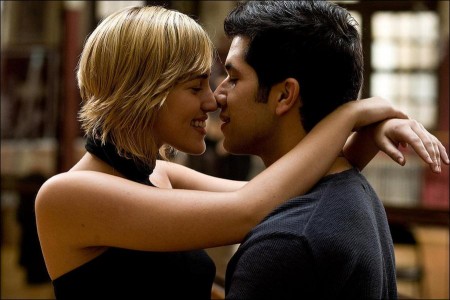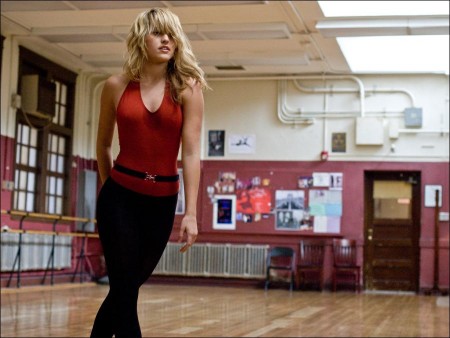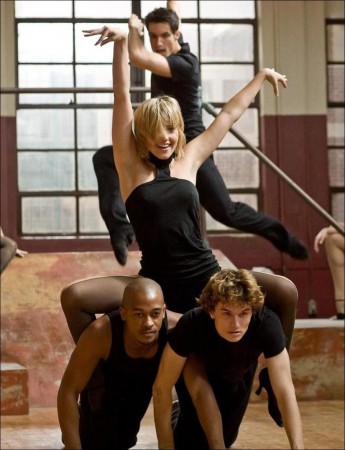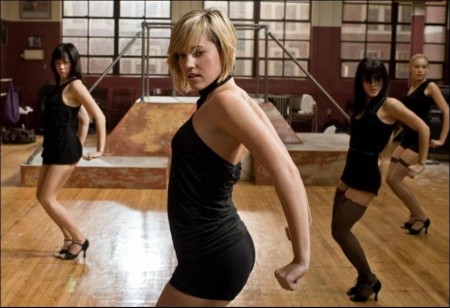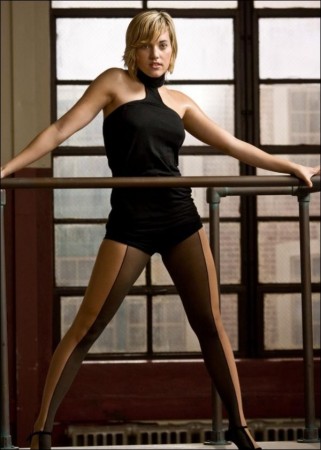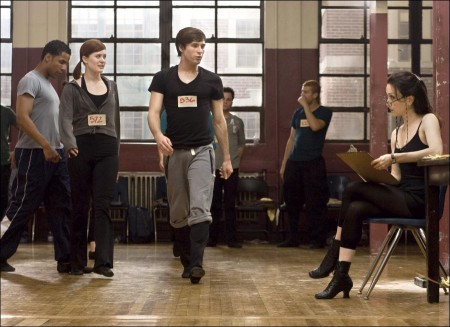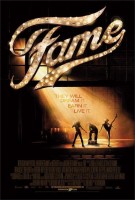Debbie Allen sees Angela Simms as a new incarnation of Lydia Grant. “As far as I’m concerned,” Allen says, “she is Lydia Grant who got married and became Ms. Simms. I said to one of the producers, `You can call me whatever you want. The audience is going to think it’s Lydia Grant up there.’ Now she’s the principal and she’s in charge.”
Simms is a role that the busy Allen understands on a very personal level. “I run the Debbie Allen Dance Academy,” she says, “and when you are in charge, you have a map, a game plan for every child that walks through the door. As Principal Simms, it’s my job in the movie, in a few brief scenes, to let the students know that there are steps you must take in order to make the most of what we have to offer you. And if you don’t complete those steps, it won’t work.”
Charles S. Dutton plays acting instructor James Dowd. Dutton, in fact, once taught at a performing arts high school in Baltimore; two of his alumni include Jada Pinkett Smith and Tupac Shakur. For this role, however, Dutton says he turned to some of his own acting teachers, who instilled in him not just a work ethic but also the notion of art as a higher calling.
“I modeled Mr. Dowd after many acting teachers that I had myself,” Dutton says. “They gave us a lot of tough love, intensity and discipline. I think Dowd tries to get his students to understand that it’s not just about being an entertainer – it’s about being an artist. There is a difference. An entertainer will do anything, but an artist will only do things he or she feels advances civilization. That’s where Dowd is coming from.”
Dutton, a graduate of the Yale School of Drama who has earned an Emmy, a Tony, and a Golden Globe nomination for his performance in August Wilson’s “The Piano Lesson,” believes that art can be a life-changing experience, independent of “fame.”
“When I realized that acting was what I was born to do,” he says, “it truly changed my life. I’ve always viewed the individual pursuit of the arts as a way to discover and rediscover your humanity. That’s what it’s all about. That’s what the real essence should be.” It is a philosophy that Dutton believes in so profoundly that, after some initial conversations about the character, Tancharoen incorporated it into a discussion Mr. Dowd has with his students.
Kelsey Grammer portrays Martin Cranston, one of the school’s music teachers. Grammer has earned a total of 16 Emmy nominations, eight Golden Globe nominations, and 16 SAG nominations; he has directed, produced, and appeared in many movies, including the recent X-Men series, as well as starring on Broadway in productions of “My Fair Lady,” “Macbeth” and “Othello.” Grammer credits a singing teacher as first inspiring him to pursue a career in the arts. He studied and prepared for his craft at Juilliard but, he says, leaving the famed school taught him a valuable lesson.
“After high school, I went to Juilliard and studied acting,” he says. “There were a couple very difficult teachers there, and there was the conservatory mentality as well – they really did make it harder for you to survive there than it would be in the real world. And, of course, I did not survive there. They kicked me out, which was a great thing for me. I’m very proud of that because I loved them dearly and they did me a favor in kicking me out because, frankly, they got my attention by doing it.”
The lessons he learned inform his portrayal of Mr. Cranston. “Cranston is a very tough character,” he says, “a difficult guy to get past. He may be the first wall these young people run into, and the value of a good wall in an artist’s life is learning how to climb over it. He is willing to nurture and shepherd young talent, but they must put in the work – he won’t let them slide. If things come too easily, he knows they won’t have a chance, especially in this profession, which comes down to a combination of talent, dedication and luck. Eventually they will run into a wall, and they need the tools to get over it.”
Wry and playful vocal instructor Fran Rowan is played by Megan Mullally. The two-time Emmy winner for Will & Grace made her debut on Broadway in “Grease” and recently completed a run in the hit musical “Young Frankenstein.” Befitting a role as voice teacher, Mullally’s singing accomplishments are as impressive as her acting – recent concert appearances include The Allen Room at Lincoln Center, The Kennedy Center, The Seattle Symphony, and Chicago’s Goodman Theatre. She also appeared as a soloist at the Walt Disney Concert Hall.
In Fame, Mullally has the opportunity to showcase her musical gifts when she takes her class to a karaoke club so they can perform in front of a live audience. Her students cajole her onto the stage, and she surprises them with a bravura rendition of the Rodgers & Hart standard “You Took Advantage of Me.” This opportunity to sing was one of the things that appealed to Mullally about joining the cast.
“The original movie had a big impact on me,” Mullally says. “I was in college and it was a big deal in my little theater community. It was one of the first movies I ever saw that had an entire cast of people my age. Also, I’m a singer, and music is very important to me. Most people know me as Karen from Will & Grace, which is great, but I’ve also done a lot of singing, just as much or more musical theater than television. So when I was offered the part of the singing teacher and she actually sings, I thought, `Well, who knows if I will ever get a part in a movie where I get to sing again?”
Mullally suggested her on-screen song – it’s one with which she has some experience. “I met with Kevin (Tancharoen) and Gary (Lucchesi) and we discussed that the whole point of the scene is that she is supposed to blow the roof off of the joint. But no pressure!” she laughs. “So we had to think of a song that’s a real barn burner. I have this band I’ve been in for a million years called Supreme Music Program, and we’d covered `You Took Advantage of Me.’ It’s the only showtune-y kind of song we’ve ever done and it’s a real crowd pleaser – we use it as our encore a lot when we play live. So I pitched that one and they loved the idea.”
Rounding out the faculty is Bebe Neuwirth as strict dance teacher Ms. Lynn Kraft. Equally at home on television, in movies, and on the stage, Neuwirth’s Broadway credits are particularly impressive. She recently starred as Roxie in the Broadway production of “Chicago,” having already won a Tony Award, Drama Desk Award, and Astaire Award for her turn as Velma in the same show – making her the only person to play both “Chicago” leading lady roles on Broadway. She also received a Tony Award for her role as Nickie in “Sweet Charity.” Her other Broadway credits include “Fosse,” “Damn Yankees,” “Dancin’,” “Little Me” and “A Chorus Line.”
Neuwirth’s passion is dance, and she founded the Dancers’ Resource Advisory Council as part of the Actors Fund, a human service organization that helps all professionals in the performing arts and entertainment. She credits dance with instilling discipline and a clear-eyed sensibility in her – traits she shares with Ms. Kraft.
“Almost all of my dance training was ballet,” Neuwirth says. “I make a living as a theater dancer and have done jazz along the way, but my training is ballet. What you gain from seriously studying ballet is a certain kind of discipline, a professionalism, a sense of where you are and where others are, literally. Let’s say you’re doing battement at the barre – those are high kicks at the barre. You have to keep an eye on the person in front of and behind you to make sure you don’t kick them. It’s a simple thing, but what that translates into, out in the world, is having a sense of space and courtesy. There are life lessons in that kind of training.
“Ms Kraft is also strongly based in ballet so she demands a strong work ethic from her students,” she continues. “I think she cares deeply for them because it’s such a difficult life. She sees so many kids come through; some will go to work and succeed and some won’t. I think she’s been at the school a long time. You wonder why she stays, and I think it is because she has the ability to see the truth, in terms of talent. She knows which kid will make it and which won’t – it’s hard but she has to lay it out for them. It’s reality, and that’s inspiring. It’s an authentic representation of what it’s like to try to become an artist. There’s a place for happy endings and also a place for inspiring people with reality, and I think that’s what this film does.”
Song and Dance
Fame is packed with fantastic, thumping music and elaborate dance routines. In reinventing the film for a modern audience, the filmmakers wanted to use some music from the original as an homage to what came before (and to keep die-hard fans happy), but they also wanted to “look to the now” and come up with a soundtrack that would be as effective blasting out of a car stereo as it is in the context of the film. To compose the soundtrack, a who’s who of modern music production was assembled to come up with a new series of songs.
“We added six new songs,” says producer Richard Wright, “but the basic story is actually very similar. What made the original film successful was that it blended a realistic narrative with great performance pieces. All the musical/dance numbers are explained because they are in a school for the performing arts – nobody suddenly starts expressing themselves by singing and dancing outside the normal reality of the narrative.”
Tancharoen says the music loomed large in his film particularly because the original raised the bar so high. “Two songs in the first film were nominated for an Oscar, and one of them won. We took the music very seriously,” Tancharoen says.
The production turned to three disparate artistic teams for the new songs: The Matrix, James Poyser, and Damon Elliott, who, collectively, have created some of the best sounds in popular music for the past ten years or so. Tancharoen made sure their musical skills fit specific scenes or characters in the movie. The Matrix oversaw the soaring, dramatic song the cast sings at graduation as well as Naturi Naughton’s rendition of “Out Here on My Own;” Poyser took on the urban-tinged music of characters Victor and Malik, specifically the score to the kids’ Halloween “Carn-evil” party, and a live club performance of “Get on the Floor” featuring Malik and Denise; Elliott handled the free-form, old school rap of what became known as the “Cafeteria Jam,” Tancharoen’s homage to the “Hot Lunch” number in the original film.
“The Matrix comprises three super producers who are singers and songwriters as well (Scott Spock, Lauren Christy, and Graham Edwards). They’ve done a huge variety of music, from Shakira all the way to Korn and Brittany,” says Tancharoen. “For some of the hip-hop, I wanted to keep it organic, so we went with James Poyser, who has worked with Erykah Badu, Common, and The Roots. He has real credibility in that world and is a really, really smart guy. `Cafeteria Jam,’ which is arguably one of the most fun scenes, went to Damon Elliott, an amazing producer. I wanted that sequence to feel as off-the-cuff as possible because it needed to feel spontaneous. It had to feel like a band jam, essentially, as opposed to someone just pressing `play’ on a CD player and everyone just happens to know the same song. It was difficult, but I think Damon knocked it out of the park.”
To move the cast’s bodies to the music, the filmmakers put the dancer/actors under the supervision of award-winning choreographer Marguerite Derricks. The main cast joined an array of talented background artists to incorporate ballet, tap, jazz, modern dance, and even gymnastics into choreographed chaos, often largely based on their initial auditions for the film. Indeed, casting the corps of background dancers was as intense and critical as selecting the principal actors.
“We were looking for more than just great dancers,” says Tancharoen. “So as much as the steps had to be good, the drive and a human quality had to be there, too. There were so many gifted kids trying out it was unreal and fantastic and also heartbreaking because we couldn’t hire everyone. It was great to see, though, the dance bar has been raised. Before, people used to specialize in jazz or ballet or tap and there was a core group of hip-hop dancers. Now, all of them are double, triple, quadruple threats – they can do it all.”
The different dance styles highlighted in the film, from ballet to jazz to hip-hop to African, are organic to the story in that they represent the variety of disciplines that would be taught at a performing arts high school. Tancharoen notes that working with Derricks to assemble this group of dancers and to choreograph the array of numbers in the movie was a dream come true, and took his relationship with her full circle.
“Marguerite is an absolute genius,” he says. “I was actually lucky enough to be in her dance company when I was a teenager, and there’s something about her energy and style that was so influential. At the time, I was strictly a hip-hop dancer – I wasn’t really into ballet or jazz – but she let me join her company, even though I was a novice at best, and really drilled me and made me learn every style, opened my eyes to the craft. She has an appreciation, love and education in every form of dance that goes beyond just a job. She has an emotional commitment, a passion for choreography and for artists, which is why she was so perfect for Fame.”
Derricks herself has a very personal relationship to the Fame franchise. “My first job as a dancer was on the Fame TV series,” Derricks says. “I was living in New York City, trying to make it on Broadway. I auditioned and auditioned, always making it to the singing part and then I would never get the job. One night, a friend of mine called and said that Debbie Allen was looking for a girl to replace someone on the second season of Fame. The next day, I auditioned for Debbie, got the job, moved to Los Angeles and never left. It was so exciting.
“Seeing the original film Fame changed my life,” she continues. “I remember leaving the movie theater and my spirit was on fire – I had to do that! Little did I know that a year and a half later I would be standing next to those people, working on the TV show. It was definitely life-changing.”
Reinventing Fame
The new, 2009 reinvention of Fame takes its inspiration from Alan Parker’s Oscar®-winning 1980 film. With its indelible images of students joyously dancing on taxicabs and Irene Cara’s hit rendition of the film’s theme song ringing in the nation’s ears, Fame became a critical hit and a film experience people took to heart. The film was nominated for six Academy Awards and won two: Best Music (Original Score) and Best Music (Original Song) for “Fame.” Its other nominations were for Film Editing, Music (Original Song) for “Out Here On My Own,” Sound, and Writing (Screenplay Written Directly for the Screen).
With a devoted fanbase, the film struck a major chord with audiences, and over the next two decades Fame became a quasi cottage industry, spawning a popular television series that ran for several seasons and lives on in syndication and on DVD, a Broadway musical, a world tour, and a reality TV show long before American Idol or So You Think You Can Dance became hit television staples. Now, almost thirty years later, a new generation is putting on their tap shoes, sitting down at the piano, and grabbing the microphone to strut their stuff.
The Fame brand’s appeal has always been in watching talented kids relentlessly pursuing their goals of success through hard work, entertaining and emoting along the way. They “pay for it in sweat.” In a world of reality TV and instant celebrity via red carpet meltdowns, and with a generation accustomed to and comfortable streaming their lives on the web via websites like YouTube, Fame counters Andy Warhol’s “15 minutes” theory with the notion of “real and lasting fame” – performances, careers, and success built on the notion of innate talent diligently honed through exhaustive discipline and never-ending practice.
“I was a huge fan of the original film, even though the nature of fame has changed dramatically in the last 25 years,” says producer Tom Rosenberg. “We wanted to follow the same sort of time arc, which was to follow the characters through four years at the High School for Performing Arts. But we didn’t want to imitate the original – we wanted the characters to be fresh and contemporary. And part of that is examining the nature of talent and hard work vs. `instant’ celebrity.
“When Alan Parker made the first film,” he continues, “the nature of fame was probably more linked to talent than it is today, and there was the perception that hard work and struggle were involved in fame. That is still true, but nowadays the idea of becoming a celebrity without talent is more prolific.” Anyone with a page on a social networking site is instantly `famous,’ and anyone with a digital camera is a potential filmmaker. “So, as in the original, the idea is to examine the real work and talent it takes to be an artist.”
To reinvent the franchise with a modern energy and flair, the producers turned to accomplished young multi-hyphenate Kevin Tancharoen, who, just like his characters, had to audition for the job. “It was a Friday afternoon, and we had met 30 or 40 directors,” says producer Gary Lucchesi, “but none felt exactly right. Kevin sat down and started talking to me about his work – he had been a dancer, met Britney Spears, had done some choreography for her, and ended up directing her worldwide tour when he was only 19, which was incredible.” His work as a choreographer also includes enormous shows with `N Sync and work with Madonna in addition to directing Spears’ “Onyx Hotel” tour. “We talked about his work with Jennifer Lopez directing Dancelife, his work with The Pussycat Dolls, and we asked him where he was from. He was from LA, grew up in the movie business, but he wasn’t a part of the privileged `elite’ – he was part of the responsible, working side, which I found quite compelling.”
Lucchesi asked Tancharoen to send him “everything he’d ever directed.” “The next day, here comes this big envelope. We were very impressed not only with the choreography but the way he shot the dance and the dramatic scenes. I showed Kevin’s work to Tom, and we agreed he was the director we had been looking for.”
Although Fame is the 24-year-old director’s first movie, his background, a mixture of music, dance, and pop culture, is the perfect blend of experience from which to draw for a movie like Fame. But while all his experience helped ready him for the job, it was the fact he connected to the material in such a personal way that Tancharoen feels made him the right guy for the job.
“Before I was a choreographer, I was that dancer with a number on his chest waiting to find out if I’d made the cut,” Tancharoen says. “I was an energetic little kid, and my sister was in a singing group called Pretty in Pink – I would have to go with her to rehearsals after school, and with all that energy bottled up I had to do something, so I ended up just trying to follow along and took to it. My mother threw me into dance classes and martial arts and I enjoyed it. All this led to some jobs professionally, which led to my interest in music. I bought some equipment and started producing songs.
“And I’ve always loved movies,” he continues. “My dad is a transportation captain on feature films, so I visited him on sets a lot. The biggest one for me was Batman Returns – I remember walking on to the sound stage and they were making snow, and there was Arnold Schwarzenegger walking around with a cigar and The Penguin and Batman and Catwoman. It was amazing, and the magic of movies still fascinates me and has certainly influenced my work.
“On this movie, on some level, I lived out my own Fame story. I’ve been doing this since I was eight and have been constantly working at it, learning new stuff, being taught by great teachers and mentors. Every element of that led to me directing this movie,” Tancharoen says.
Since the original Fame, Tancharoen agrees the landscape has changed in terms of what audiences expect from a film full of dance, music and drama. With entertainment reality competitions on TV, “The History of Dance” and its ilk on the web, and movie hits like Save the Last Dance and Step Up, “all genres of dance and musical performance have been showcased in really mainstream, entertaining ways,” he says. “Now we have a more educated audience; the bar has been raised. We’ve seen people defy physics by spinning on their heads, sliding across the floor. We’ve seen bravura singers from rock to rap to country.” Tancharoen wanted to make sure and raise the bar in his own film, and it was one of his working mantras during production.
That said, with all the “new,” he wanted to make sure and keep the film rooted in what makes it unique and compelling. “When the original Fame came out,” he says, “it was a novelty. It represented musicals taking a shift from the MGM classics of the 1950s. It also really showcased what it was like to be a struggling teenage artist, to want it so badly and still not be assured of success – not everyone makes it. What we’re trying to do, I think, is recapture the core of that idea and marry it with the new dance and performance styles. It’s not just the dance and the song – it’s the stories behind the dance and the song.”
To showcase those young artists’ struggles, Tancharoen wanted to assemble an ensemble of gifted newcomers who, in many respects, reflected their characters in real life. The young performers in the film are, in many ways, living in real life what their onscreen characters are going through, which lends the film’s stories an honesty and affecting immediacy. “The cast brings an authenticity to the characters,”
Tancharoen says. “They understand this world. Essentially, they themselves are the characters in the movie.” The actors felt very invested in their characters, and it made the project incredibly special for each of them, personalizing their roles.
Backstage
Although the production filmed most of the interiors in Los Angeles, the company filmed the exteriors in New York, and Manhattan locales dictated the entire look of the film, especially the actual performing arts high school.
“There are two of them in New York, and we decided the one we’d shoot is in the theater district. It has an architectural character that has a New York feeling to it,” says production designer Paul Eads. “As luck would have it, one of the schools we chose in Los Angeles had a very similar window configuration, built in the same era as the high school in New York. We split all the interior work between five different schools in Los Angeles – we shot corridors and the graduation auditorium in one, the dance classroom in another, drama class in another, cafeteria in another. We were all over the map, but I had complete control over the color palette and the choice of architecture.”
The look of the film is also greatly influenced by the clothing worn by the cast. Because the film is about artists, costume designer Dayna Pink wanted to make sure each piece worn reflected the characters’ – and the actors’ -individualism.
“No primary colors, but a lot of jewel tones – sapphire, eggplant and ruby,” Pink says. “What we tried to do was make it real and still let their personalities shine through. We didn’t want the clothes wearing the kids, we wanted the kids wearing the clothes.”
Each character has their own “color family” and personal style. Denise, for instance, favors pinks and purples, conservative preppy cardigans that culminate in a fitted, silk fuchsia dress she wore at graduation; Neil’s trademark hats, skinny ties, pants and oversized sweaters became less quirky over time. As the kids mature throughout their four years at school and as their experiences at the school begin to affect them, Pink’s clothes become more sophisticated and streamlined.
“If you think about the difference between a 14-year-old and an 18-year-old, those are totally different people,” Pink says. “Things happen in that time period that will change you forever, and that’s reflected in your dress. A 14-year-old is usually more self-conscious, a little awkward. By the time they’re 18, all the things they’ve gone through have made them a little more confident, more self aware. And all that is reflected in the wardrobe.”
Production notes provided by Paramount Vantage.
Fame
Starring: Debbie Allen, Charles S. Dutton, Kelsey Grammer, Kherington Payne, Megan Mullally, Bebe Neuwirth, Thomas Dekker, Kristy Flores, Paul Iacono
Directed by: Kevin Tancharoen
Screenplay by: Allison Burnett, Aline Brosh McKenna
Release Date: September 25, 2009
MPAA Rating: PG for thematic material including teen drinking, a sexual situation and language.
Studio: Paramount Vantage
Box Office Totals
Domestic: $22,441,612 (53.8%)
Foreign: $19,258,180 (46.2%)
Total: $41,699,792 (Worldwide)

